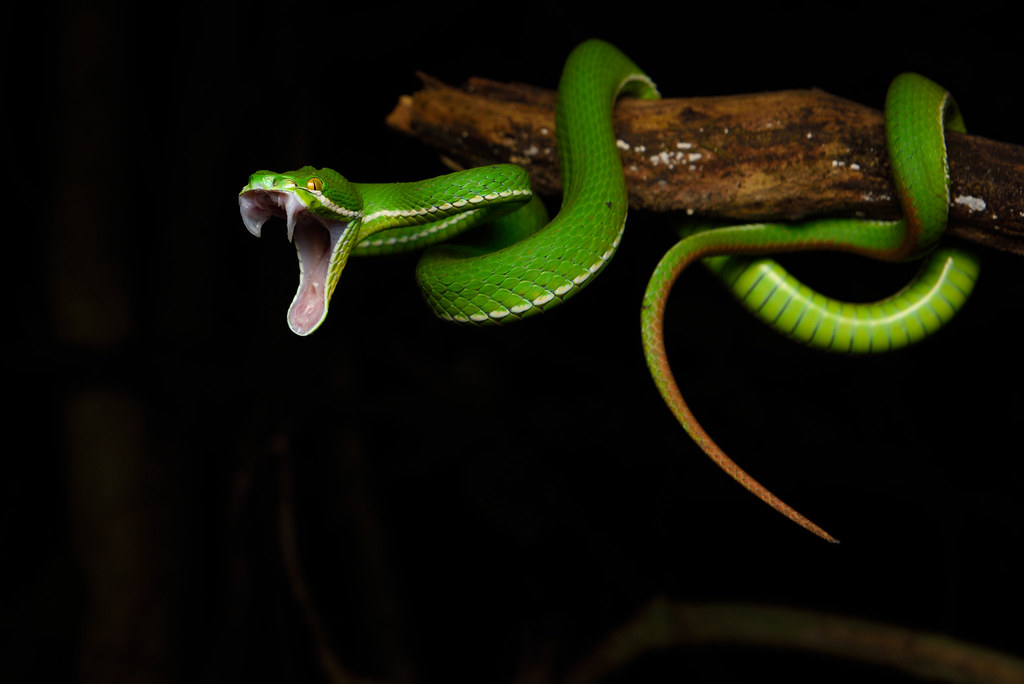Venomous snakes have evolved some of the most sophisticated biochemical weapons on Earth. These remarkable reptiles can produce complex venoms that immobilize prey, aid digestion, and serve as powerful defensive tools. What makes snake venoms particularly fascinating is their diversity – specifically the evolution of two primary venom types: hemotoxic and neurotoxic. These distinct venom categories represent different evolutionary solutions to the same problem: how to efficiently secure food while minimizing risk. This article explores why different snake species evolved these specialized venom types, the mechanisms behind their deadly effectiveness, and what these differences mean for both snake ecology and human medicine.
The Fundamental Difference Between Hemotoxic and Neurotoxic Venoms

Hemotoxic and neurotoxic venoms represent two fundamentally different approaches to subduing prey, each targeting distinct physiological systems. Hemotoxic venoms primarily attack the cardiovascular system, destroying blood cells, disrupting clotting mechanisms, and damaging tissue and blood vessels. These venoms essentially break down the structural integrity of an organism from the inside out, causing hemorrhaging, necrosis, and eventual organ failure. Neurotoxic venoms, by contrast, target the nervous system by blocking nerve impulses, disrupting neuromuscular junctions, or overstimulating nerve cells, leading to paralysis, respiratory failure, and death. While both venom types are lethal, they operate through entirely different pathways and produce dramatically different symptoms in victims, reflecting the distinct evolutionary pressures that shaped them.
The Evolutionary Origins of Snake Venom

Snake venom didn’t appear suddenly in evolutionary history but developed gradually over millions of years from ordinary salivary proteins that underwent duplication and modification. Research suggests that the foundation for venom systems appeared roughly 170 million years ago in the common ancestor of modern venomous snakes. These proto-venoms likely began as mildly toxic saliva that helped subdue prey and aided digestion. As snakes evolved and diversified, natural selection favored individuals with more effective toxic compounds, leading to increasingly potent and specialized venoms. This evolutionary arms race has continued to the present day, with snake venom representing one of the most rapidly evolving protein systems known in vertebrates. Genomic studies reveal that venom genes mutate and diversify at rates significantly higher than other genes, highlighting the intense selective pressure on these defensive and predatory adaptations.
Hemotoxic Venom: The Tissue Destroyer

Hemotoxic venoms are complex cocktails containing enzymes like metalloproteases, serine proteases, and phospholipases that systematically break down tissues and cell structures. These enzymes disrupt the blood’s coagulation cascade, sometimes causing contradictory effects – some components trigger abnormal clotting while others prevent clotting entirely, leading to internal bleeding. The tissue destruction caused by hemotoxic venom serves multiple functions beyond simply killing prey. By breaking down structural proteins and cell membranes, these venoms effectively begin the digestive process before the prey is even consumed, allowing snakes to digest their meals more efficiently. Additionally, the extensive tissue damage makes prey easier to track if it initially escapes, as it leaves a trail of blood or becomes immobilized due to necrosis. The pain and tissue damage from hemotoxic venoms also serve as powerful deterrents against predators that might threaten the snake.
Neurotoxic Venom: The Paralysis Inducer

Neurotoxic venoms contain highly specialized proteins and peptides that interfere with nerve signal transmission throughout the body. These toxins typically work by either blocking acetylcholine receptors at neuromuscular junctions (post-synaptic neurotoxins) or preventing the release of acetylcholine from nerve terminals (pre-synaptic neurotoxins). The result is rapid paralysis that can affect vital functions like respiration, leading to death by asphyxiation while the victim remains conscious. Some of the most potent neurotoxins, like those found in cobra and mamba venoms, can immobilize prey within minutes or even seconds. This rapid action provides a significant advantage for snakes hunting agile prey that might otherwise escape or injure the predator. Additionally, because neurotoxic venoms typically do not cause extensive tissue damage, they allow snakes to consume prey quickly without waiting for tissue-destroying enzymes to do their work.
Ecological Influences on Venom Type

The type of venom a snake species produces is strongly influenced by its ecological niche and hunting strategy. Vipers and pit vipers, which typically ambush rodents and other small mammals, predominantly use hemotoxic venoms that allow them to strike quickly and then track their prey as it flees and eventually succumbs to the venom. These snakes often hunt in environments where prey can escape into burrows or dense vegetation, making the “bite and release” strategy advantageous. In contrast, elapids like cobras, mambas, and sea snakes produce primarily neurotoxic venoms that rapidly immobilize prey, allowing these active hunters to safely capture prey without prolonged struggles. This is particularly important for snakes that hunt in open environments where extended pursuit would be energetically costly or dangerous. These ecological specializations demonstrate how venom composition is shaped by natural selection to match a species’ specific hunting requirements and habitat constraints.
Dietary Specialization and Venom Evolution

A snake’s diet plays a crucial role in determining the composition of its venom, with many species evolving toxins specifically targeted to their preferred prey. This phenomenon, known as prey-specific toxicity, explains why some venoms are extraordinarily lethal to certain animals while having minimal effects on others. For example, the Eastern brown snake’s venom is particularly effective against mammals but less toxic to birds, reflecting its mammal-heavy diet. Similarly, many sea snakes produce venoms highly toxic to fish but relatively less dangerous to mammals. Some of the most fascinating examples of dietary specialization come from egg-eating sea snakes that have lost their potent neurotoxins entirely, as they no longer need venom for prey capture. These examples illustrate the remarkable specificity of venom evolution and how it adapts to target the physiological vulnerabilities of a snake’s typical prey, maximizing hunting efficiency while conserving the metabolic resources required for venom production.
The Complexity of Venom Cocktails

Snake venoms are far more complex than simply “hemotoxic” or “neurotoxic,” with most species producing sophisticated blends containing dozens or even hundreds of different bioactive compounds. This complexity allows venoms to simultaneously attack multiple physiological systems, overwhelming the prey’s defenses. Many snakes produce venoms with both hemotoxic and neurotoxic components, with one type typically predominating. For instance, rattlesnake venom is primarily hemotoxic but contains neurotoxic components that contribute to its lethality. The components in these venom cocktails often work synergistically, enhancing each other’s effects through processes that scientists are still working to fully understand. This biochemical complexity helps explain why antivenom development is so challenging – neutralizing one or two venom components is insufficient when dozens of others remain active. This biochemical diversity also makes snake venom an invaluable resource for pharmaceutical research, as each component potentially represents a highly specific tool for understanding and potentially treating human diseases.
Geographic Variation in Venom Composition

One of the most intriguing aspects of snake venom is how it can vary significantly within a single species across different geographic regions. This phenomenon, known as venom variation, can be so pronounced that snakes of the same species from different locations might produce venoms with substantially different compositions and effects. The tiger snake in Australia, for example, shows dramatic venom variation across its range, with populations on islands producing venoms specialized for the local prey. Similarly, the Mojave rattlesnake has populations producing primarily hemotoxic venom in some regions and more neurotoxic venom in others. These variations create significant challenges for antivenom production, as treatments effective against one population’s venom may provide limited protection against another’s. Scientists attribute these geographic differences to local adaptation, genetic drift, and ongoing evolutionary processes that continue to shape venom composition in response to local ecological conditions and prey availability.
Venom Delivery Systems and Their Relationship to Toxin Type

The physical mechanism by which snakes deliver venom is closely tied to the type of toxins they produce. Front-fanged venomous snakes like vipers have developed sophisticated hollow fangs that work like hypodermic needles, injecting venom deep into tissue – an adaptation particularly suited for delivering hemotoxic venoms that need to enter the bloodstream to be effective. These snakes typically have long, hinged fangs that fold back when the mouth is closed and rotate forward when striking. By contrast, many elapids (cobras, mambas, and coral snakes) have shorter, fixed front fangs with external grooves rather than complete hollow channels, which effectively deliver their fast-acting neurotoxic venoms to superficial tissues where they can be rapidly absorbed. Rear-fanged snakes represent yet another variation, with enlarged grooved teeth at the back of their mouths that require them to chew venom into their prey – a system that works with their typically milder venoms. These different delivery mechanisms have co-evolved with venom composition to create integrated predatory systems optimized for each snake’s hunting strategy.
Medical Consequences and Treatment Differences
The distinction between hemotoxic and neurotoxic venoms has profound implications for snakebite treatment and victim survival. Hemotoxic envenomation typically presents with progressive swelling, blistering, pain, and tissue necrosis, with systemic effects including hemorrhaging, cardiovascular collapse, and organ damage developing over hours or days. These bites, while potentially fatal if untreated, often provide a longer window for medical intervention. Neurotoxic envenomation, by contrast, may initially show little local reaction but rapidly progress to neuromuscular symptoms including ptosis (drooping eyelids), difficulty speaking or swallowing, and ultimately respiratory paralysis that can cause death within hours. Medical treatment approaches differ significantly between these venom types, with neurotoxic bites often requiring respiratory support and rapid antivenom administration, while hemotoxic bites may additionally need treatment for coagulopathy, compartment syndrome, and extensive tissue damage. This medical distinction underscores why accurate snake identification is crucial for proper treatment, though polyvalent antivenoms that neutralize multiple venom types have improved outcomes in regions where species identification is uncertain.
Venom Resistance and Evolutionary Arms Races

The evolution of snake venom exists within a broader context of predator-prey arms races, where prey species develop resistance while snakes evolve increasingly potent toxins. Some of the most remarkable examples come from small mammals like opossums, mongoose, and certain rodents that have evolved physiological resistance to snake venoms through modified receptor proteins that no longer bind to venom components. In response, snakes continually evolve new toxin variants that can overcome these resistances, leading to an ongoing evolutionary battle. This dynamic is particularly evident with neurotoxic venoms, where specific mutations in acetylcholine receptors can render prey immune to certain neurotoxins. The California ground squirrel, for example, has developed significant resistance to rattlesnake venom in areas where they coexist, while remaining vulnerable to venoms from snakes outside their range. These evolutionary arms races drive venom diversification and help explain the remarkable complexity and potency of modern snake venoms, as well as why venom composition continues to evolve rapidly even in contemporary snake populations.
Venom as a Biomedical Resource

The specialized compounds in snake venoms represent a vast and largely untapped pharmaceutical resource, with both hemotoxic and neurotoxic components offering unique medical applications. Hemotoxic venom components have led to the development of medications like captopril, an angiotensin-converting enzyme inhibitor derived from pit viper venom that revolutionized hypertension treatment. Other hemotoxic venom components are being investigated as potential treatments for thrombosis, heart attacks, and certain cancers due to their ability to precisely target blood clotting mechanisms and cell membranes. Neurotoxic venom components offer equally promising medical applications, particularly for conditions involving the nervous system. These toxins provide extremely specific tools for studying neural receptors and have led to the development of powerful pain medications like ziconotide, derived from cone snail venom. The exceptional specificity of these toxins makes them invaluable for understanding brain function and developing treatments for conditions ranging from Alzheimer’s disease to chronic pain. As analytical techniques improve, researchers continue to discover new bioactive molecules in snake venoms that may hold the key to treating previously intractable medical conditions.
The Future of Venom Research and Conservation

As technology advances, our understanding of snake venoms continues to deepen through techniques like proteomics, genomics, and high-throughput screening that reveal the full complexity of these biochemical arsenals. This research has practical applications beyond medicine, including the development of better antivenoms with fewer side effects and broader coverage against multiple snake species. However, this promising research faces significant challenges from habitat destruction and snake population declines worldwide, which threaten to diminish this biodiversity before we can fully understand or utilize it. Many potentially valuable venom components may be lost forever if rare snake species become extinct before their venoms can be properly studied. Conservation efforts are therefore essential not only for maintaining healthy ecosystems but also for preserving this biochemical diversity that represents millions of years of evolutionary innovation. The future of venom research depends on both technological advancement and successful conservation initiatives that protect these remarkable reptiles and their unique biochemical adaptations.
Conclusion

The evolution of hemotoxic and neurotoxic venoms represents one of nature’s most sophisticated examples of adaptive specialization. These distinct venom types reflect the diverse ecological niches, hunting strategies, and evolutionary pressures that have shaped snake species over millions of years. Far from being simple poisons, these venoms are complex biochemical systems precisely tuned to each species’ survival needs. As we continue to unravel the molecular mechanisms and evolutionary history of these toxins, we gain not only a deeper appreciation for nature’s complexity but also access to unique compounds with the potential to revolutionize medicine. The story of snake venom evolution reminds us that some of nature’s most dangerous adaptations may also hold solutions to humanity’s most pressing medical challenges – if we can preserve these species and their remarkable biochemical diversity for future generations.




